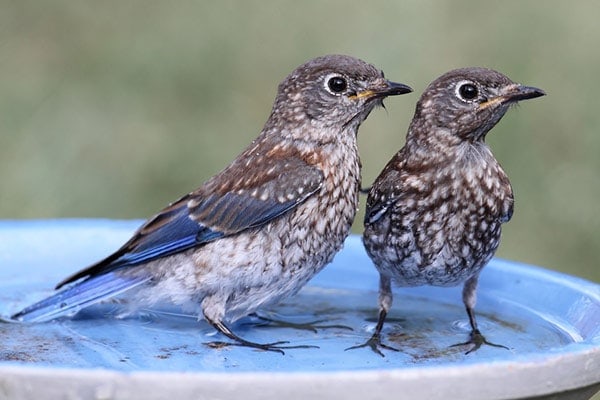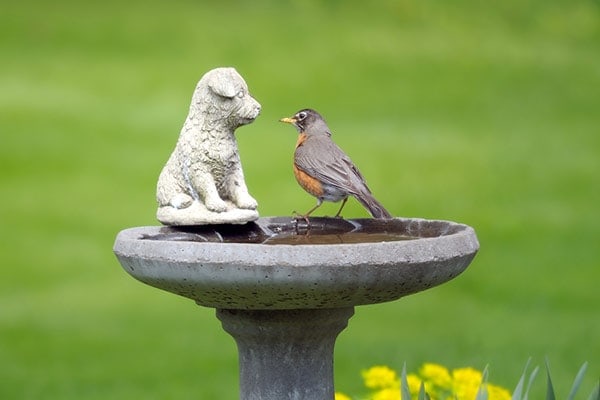Contents
- Changing Bird Bath Water: Critical Reasons Why It’s Essential
- How High Should I Fill The Water In My Bird Bath?
- Debris & Dirt Buildup: The Most Common Types
- Keeping It Clean: Tips To Maintain Immaculate Bird Bath Water
- Algae Prevention: How to Stop The Spread Of This Dreaded Contaminant Dead In Its Tracks
Knowing when to change bird bath water isn’t as clear-cut as it seems. Do you wait until the water becomes dirty, starts to run dry, or something else entirely? I needed to know the truth, so I researched this topic and discovered some interesting facts that I’ll tell you about below.
Since most birds drink water every day, it’s best to provide them with clean, fresh bathing and drinking water. On average, experts agree that bird bath water needs to be changed every 2-4 days. Keep the bath clean and well maintained. Change the water immediately if you notice a buildup of dead bugs, red or green algae, bird seed and hulls, bird feces, and more.
In truth, there’s a lot more to share on this topic including things like:
- A detailed explanation of the reasons to change bird bath water
- How to determine the ideal water level for your bird bath
- Types of dirt and debris buildup in bird baths
- Tips to keep bird bath water clean
- How to prevent algae from contaminating bird bath water
Let’s jump in headfirst and get started…

Changing Bird Bath Water: Critical Reasons Why It’s Essential
It shouldn’t surprise anyone to learn that it’s necessary to keep their bird bath water clean. This is the best way to ensure that the birds visiting your backyard stay healthy and happy for as long as possible. It’s a great way to maintain your personal health as well.
If you need further convincing, some critical reasons why it’s essential to change the water include:
- Prevents the water from becoming polluted
- Cuts down on mosquito and gnat populations
- Prevents the spread of diseases among the bird population
- Prevents the spread of diseases among the human population
- Provides healthier and tastier water for the birds
- Clean water is more attractive to birds
Related post: Best Solar Bird Baths
How High Should I Fill The Water In My Bird Bath?
According to Audubon.org, “Be sure the water is only about an inch (2.5 cm) to an inch-and-a-half (3.8 cm) deep.” Shallow water levels are recommended because it’s similar to how birds clean themselves in nature.
Typically, when a bird cleans itself in its natural habitat, it does so by bathing in a shallow puddle. This is a natural birdbath for a bird, so it’s best to try and mimic the water level of their natural environment.
And AllAboutBirds.org has similar feelings. They believe, “the water should be no deeper than 0.5 to 1 inch at the edges, sloping to a maximum of 2 inches deep in the middle of the bath.”
Debris & Dirt Buildup: The Most Common Types
As you can imagine, there are many reasons to keep bird bath water clean and pristine. Some of the most common and challenging issues include:
Bird Feces Accumulation
The accumulation of bird droppings creates a breeding ground for parasites and other potential diseases. Not only are these diseases harmful to other birds, but they can also spread to humans and cause erosion to the foundation of a house or apartment building.
According to buildings.com, “Diseases such as Histoplasmosis, Asperuillosis, Cryptococcis, Encephalitis, Salmonella, and Lasteriosas can spread through bird excrement and nesting materials.”
To avoid illness and spreading parasite-related diseases like psittacosis, an illness that causes muscle aches, weakness, chills, and fever in humans, you should:
- Remove bird droppings right away
- Clean your bird bath with chlorine bleach to prevent buildup
- Repeat these steps as necessary
Berries, Seed Hulls, and Seeds
It shouldn’t surprise anyone to learn that bird food like seeds, berries, and hulls end up contaminating bird bath water. These contaminants dirty the water and create a potentially toxic environment that could lead to even more disease.
To stop this from happening, make sure your bird feeder and bird bath aren’t right next to or above one another. Hanging your bird feeder above the bird bath leads to spillage that will easily contaminate the water.
Grass & Leaves
It’s unavoidable, so you should expect to experience leaves and grass buildup in your bird bath water. Even though it’s going to happen no matter how hard you try, you can take steps to cut down on the buildup.
Some things to consider include:
- Do not place the basin directly underneath a tree with lots of leaves
- Keep your bird bath in a garden with lots of vegetation but little grass

Dust & Dirt
Dust and dirt are always floating around in the air. It’s impossible to keep it out of your bird bath. Not only will it drift in on its own from the wind, but birds and other small wildlife carry it around on their bodies and they’ll unintentionally contaminate the water while cleaning themselves or drinking out of the basin.
Mosquitoes & Dead Bugs
Bugs are attracted to water. It’s a fact of life that we all have to live with. In particular, mosquitoes tend to gravitate toward water and they can contaminate it with deadly diseases.
There’s only one way to prevent your water from being contaminated by mosquitoes. And the answer is to simply change the water as often as possible.
Why? Mosquitoes grow to adult size in 7-10 days. Changing the water quickly ends their life cycle before they reach adulthood.
At a minimum, it needs to be changed every 2-4 days.
Bird Feathers
Bird feather buildup will also happen if you have an active and well-used bird bath. Stay on top of the feathers and pick them out of the basin regularly to keep them contained.
Keeping It Clean: Tips To Maintain Immaculate Bird Bath Water
Keeping a birdbath clean is never going to be easy, but there are certain steps you can take to ensure cleanliness as much as possible. At frequent intervals, you’ll need to clean your bird bath, but these tips will help cut back on the need to frequently clean the basin due to excessive dirt and grime buildup.
Consider the following:
- Do not dump fresh water on top of stagnant water in your bird bath. Remove the old water and quickly wipe down the basin before refilling it with clean water.
- Keep the bird bath positioned away from excessive amounts of debris, falling leaves, and grass clippings. This way you won’t have to worry about extreme amounts of excessive dirt and debris overwhelming the bowl or basin.
- Placing your bird bath in a shady area will minimize the growth of algae, which we’ll go into in greater detail about next. Try to keep your bird bath in the shade, but also avoid placing it under a tree because that will lead to tree bark, leaves, and other dirty buildup.
- Keep the bath as far away from bird feeders as you possibly can. This will prevent seeds, berries, and hulls from falling in the water and dirtying or contaminating the otherwise crystal-clear liquid.
Algae Prevention: How to Stop The Spread Of This Dreaded Contaminant Dead In Its Tracks
Unfortunately, it’s common to find algae growing in a bird bath. As a matter of fact, algae spores are simply transferred to basin water from bird feet, trees, and the wind. This makes it difficult to keep it from growing in your basin if you aren’t prepared.
On the other hand, it’s certainly possible to prevent algae growth from overwhelming the bath and water. I’ll share three ways to prevent this problem and keep it from turning your water green or red.
Prevention Method #1: Algae Growth Reduction
- First, remove algae immediately as soon as you see it. This will prevent an infestation from growing on the bottom of your bird bath. Empty the water, wipe it down, and refill it with fresh water.
- Next, add a biodegradable ball to the basin. They sell these in local hardware stores, gardening stores, or at your favorite online retailer. It’s specifically designed to stop algae from infiltrating your water.
- Third, add enzymes to the water. The enzymes are safe for birds and prevent algae growth for around 30 days.
Prevention Method #2: Regular Bird Bath Cleanings
- Empty the water
- Scrub the basin using a scrub brush
- Rinse out the basin and use a chlorine bleach solution when necessary
- Refill your birdbath
Prevention Method #3: Algae Development Preventative Measures
- Keep your bird bath shaded and away from direct sunlight. Remember that bird feeders and shrubs also create contamination, so keep it away from them when possible.
- Change the water each day. By adding fresh water every day, you’ll eliminate the possibility of allowing algae to grow unabated. Remove visible signs of algae as you change the water.
- Add movement to your basin water. Heaters, drippers, bubblers, and pumps keep the water moving constantly. Moving water is less likely to experience algae contamination when compared to stagnant water.
